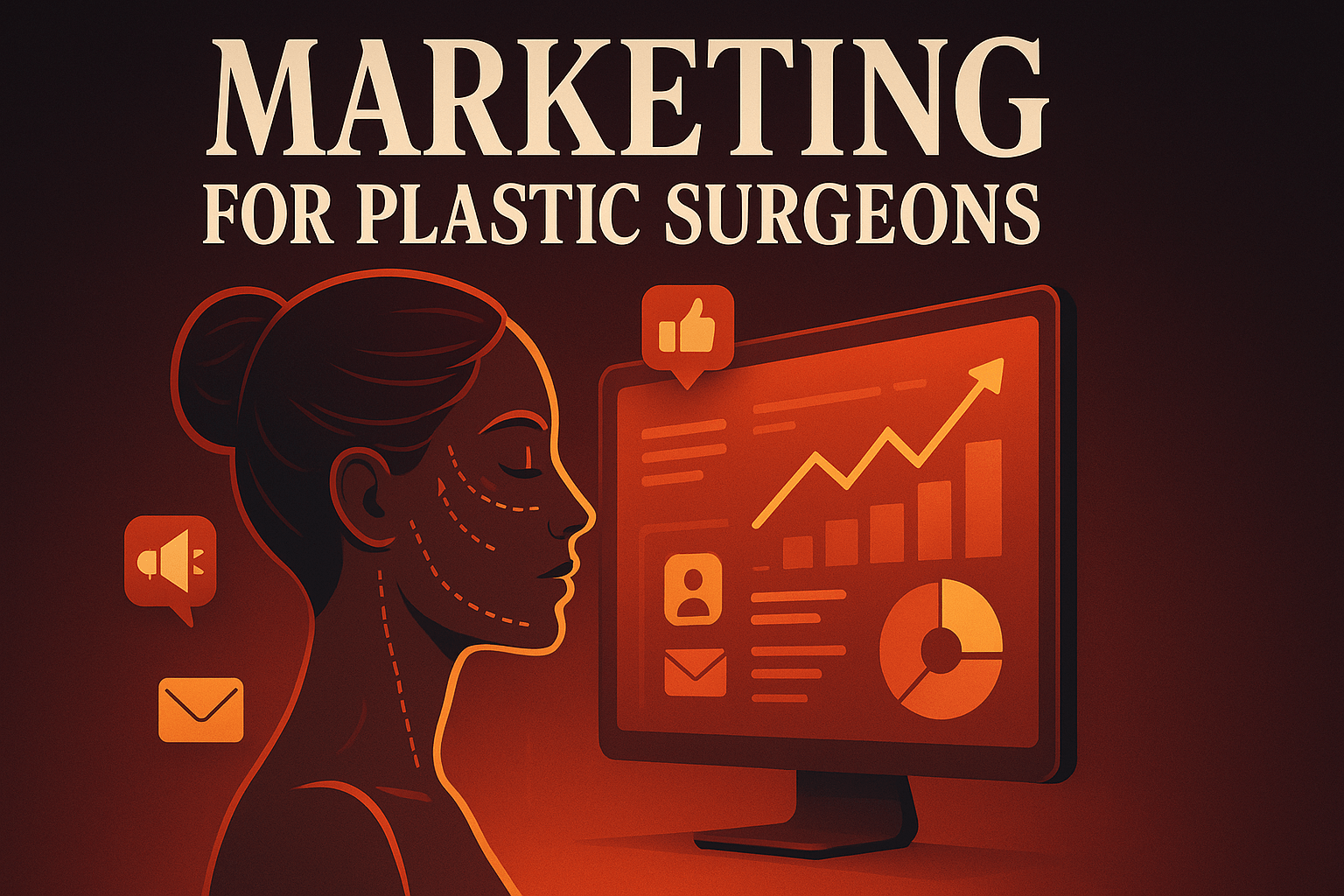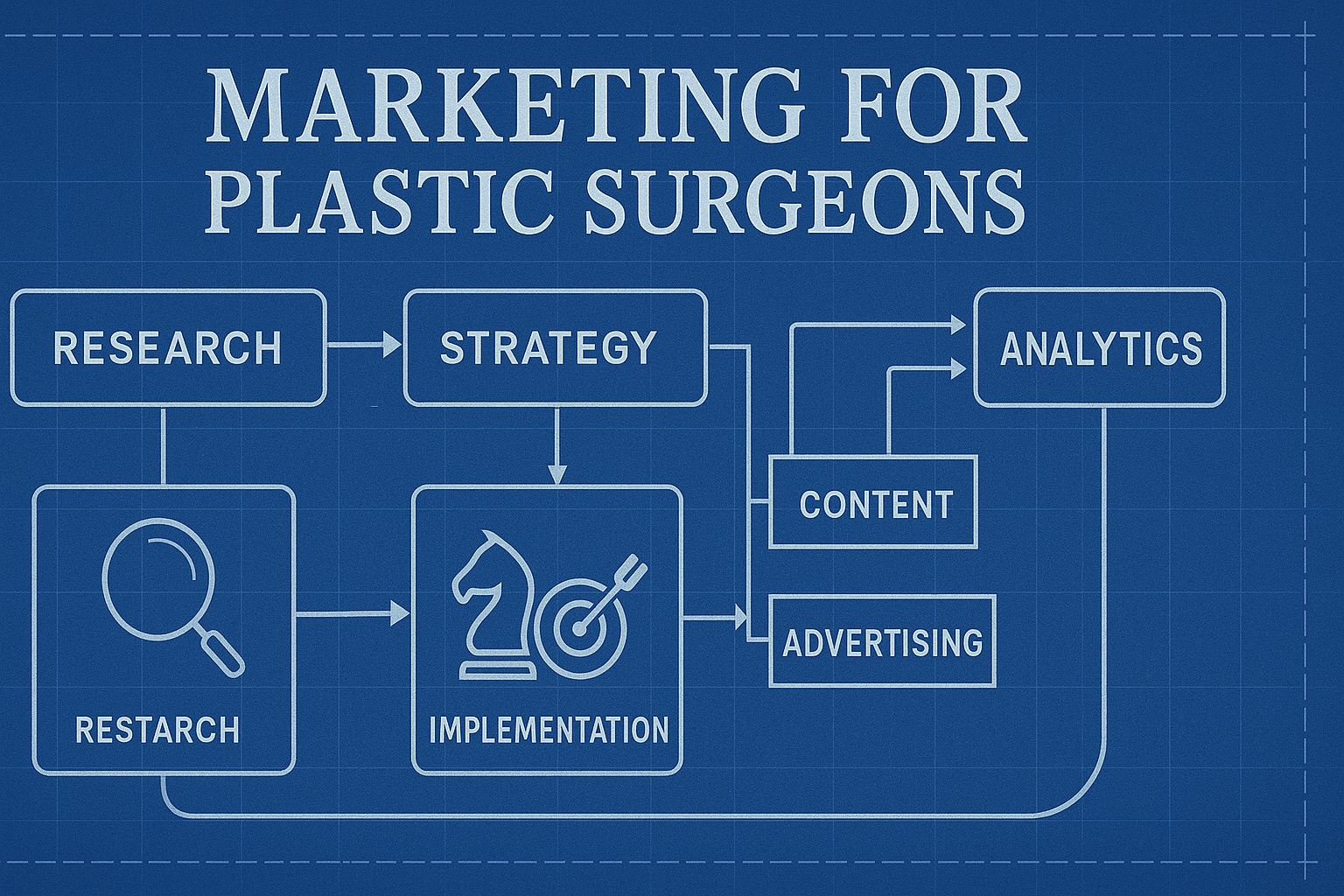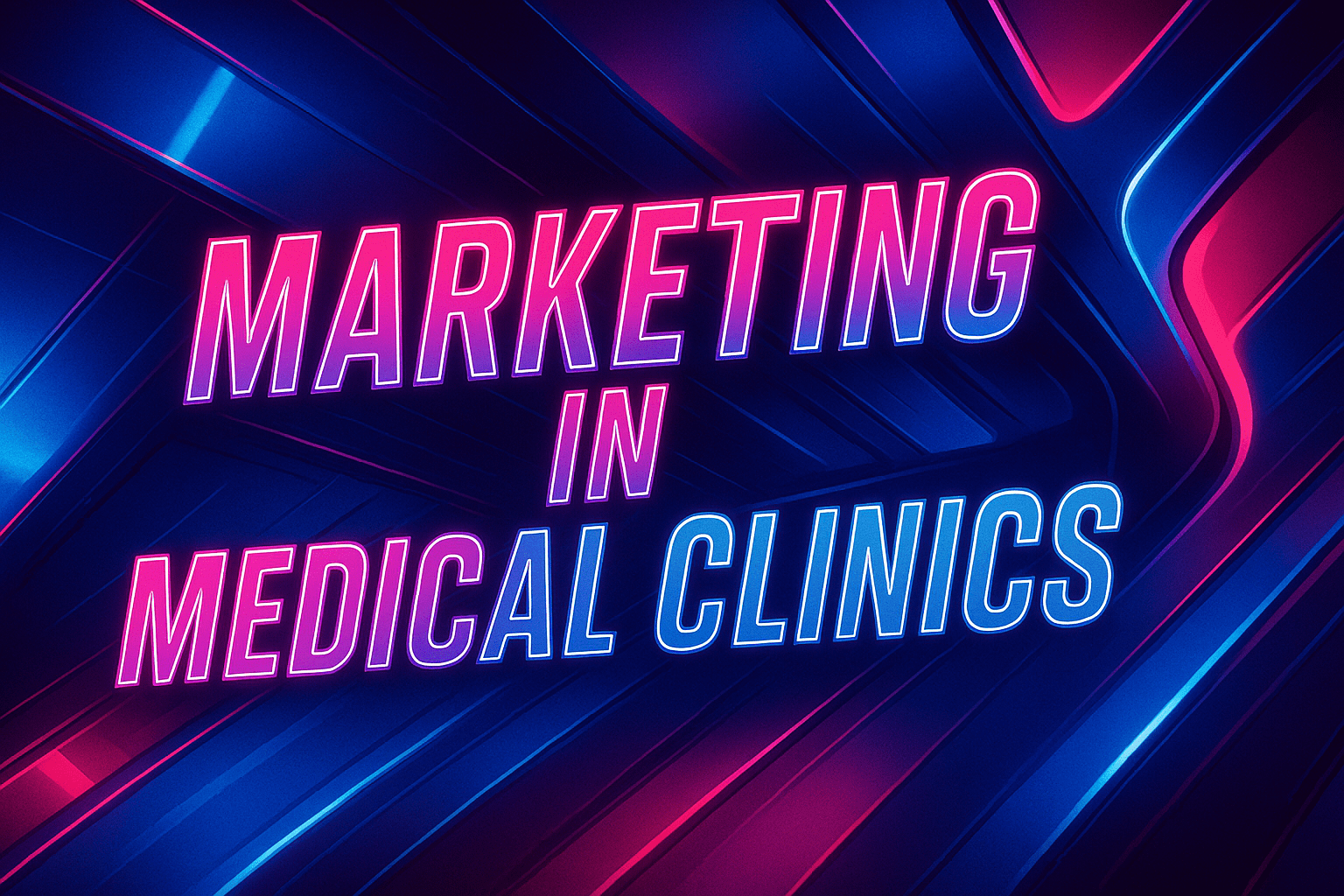Complete Marketing Guide for Plastic Surgeons: Strategies to Attract More Patients in 2026
by Design Delulu Editorial · October 28, 2025

Smart, fast, and measurable. Here's how marketing helps Plastic Surgeons win.
The plastic surgery landscape has transformed dramatically. With more consumers researching procedures online before ever contacting a practice, your digital presence determines whether you capture high-intent patients or lose them to competitors. Traditional referral networks alone no longer sustain growth—today's successful practices combine relationship marketing with sophisticated digital strategies that meet patients where they search, compare, and decide.
Marketing for plastic surgeons requires a fundamentally different approach than general healthcare marketing. Your patients invest significant resources into elective procedures, conducting extensive research across multiple channels before booking consultations. They evaluate your credentials, scrutinize before-and-after galleries, read detailed reviews, and assess whether your practice aesthetic aligns with their desired outcomes. This extended consideration cycle means your marketing must educate, build trust, and differentiate your expertise across every touchpoint—from initial search queries to post-consultation follow-ups.

Why Marketing Matters for Plastic Surgery Practices
The competitive dynamics in plastic surgery have intensified. Patients now compare multiple surgeons before deciding, influenced by online reviews, social media presence, educational content, and peer recommendations. Without strategic marketing, even highly skilled surgeons struggle to maintain consistent patient flow.
Patient acquisition costs continue rising as more practices compete for the same keywords and audiences. The surgeons who win aren't necessarily the most experienced—they're the ones who effectively communicate their value proposition, showcase authentic results, and create seamless patient journeys from discovery to booking.
Marketing also addresses critical business challenges: reducing seasonality fluctuations by building year-round awareness, maximizing lifetime value through retention campaigns, and attracting ideal patients who align with your practice philosophy and procedure specialties. When executed properly, marketing becomes your most predictable patient acquisition channel.
The return on investment speaks for itself. Practices that implement comprehensive marketing strategies report 40-60% increases in consultation bookings within six months, with reduced reliance on expensive pay-per-click advertising as organic visibility compounds. The key lies in treating marketing as a systematic process, not a collection of random tactics.
Core Components of Effective Plastic Surgery Marketing
Successful marketing for plastic surgeons integrates multiple channels into a cohesive ecosystem. Each component reinforces the others, creating compound effects that dramatically outperform isolated efforts.
Search Engine Optimization (SEO)
SEO forms the foundation of sustainable patient acquisition. When potential patients search for procedures like rhinoplasty, breast augmentation, or facelift in your geographic area, your practice must appear prominently. This requires technical optimization (site speed, mobile responsiveness, structured data), on-page SEO (keyword-optimized procedure pages, location targeting), and off-page authority (quality backlinks, directory citations).
For plastic surgeons, local SEO proves particularly valuable. Optimizing your Google Business Profile, earning consistent NAP citations across directories, and generating authentic patient reviews directly impact your visibility in local map pack results—often the first thing potential patients see when searching.
Content depth matters significantly. Comprehensive procedure pages that address patient questions, explain techniques, discuss recovery timelines, and showcase results outrank thin content. Include FAQ sections, video content, and detailed before-and-after galleries that demonstrate your expertise and outcomes.
Content Marketing Strategy
Educational content positions you as the trusted authority while capturing patients throughout their research journey. An effective content strategy maps topics to different stages of patient awareness:
- Awareness stage: General topics like "signs of aging" or "body contouring after weight loss" that attract early-stage researchers
- Consideration stage: Procedure comparisons, technique explanations, and recovery guides for patients evaluating options
- Decision stage: Surgeon credentials, patient testimonials, consultation preparation guides for those ready to book
Blog posts, video content, downloadable guides, and case studies serve different purposes in this journey. The goal isn't random content production—it's strategic asset creation that answers specific patient questions, ranks for valuable keywords, and moves prospects toward consultation.
Consistency and quality trump volume. Publishing two exceptional, deeply researched articles monthly outperforms eight shallow posts. Focus on topics your ideal patients actually search for, validated through keyword research and patient question analysis.
Social Media Presence
Instagram and TikTok have become primary research channels for plastic surgery patients, particularly for younger demographics. These platforms enable you to showcase results, explain procedures, address misconceptions, and build personal connection with your audience.
Visual content performs exceptionally well: before-and-after transformations (with proper consent), procedure explanation videos, patient journey stories, and behind-the-scenes practice content. Educational posts that answer common questions or debunk myths generate significant engagement and shareability.
Authenticity matters more than production polish. Patients respond to genuine expertise and relatable communication, not overly produced corporate content. Share your professional perspective, treatment philosophy, and the artistry behind your work in ways that feel accessible and trustworthy.
Paid social advertising complements organic efforts, enabling precise targeting based on demographics, interests, and behaviors. Retargeting campaigns keep your practice top-of-mind for website visitors who haven't yet booked consultations.
Email Marketing & Patient Nurture
Email remains one of the highest-ROI marketing channels for practices. Segmented campaigns enable personalized communication based on patient interests, consultation history, and procedure considerations.
Effective email sequences include: consultation follow-ups that address common concerns, educational series about specific procedures, seasonal promotions for treatments with optimal timing, and post-procedure care guidance that improves outcomes and satisfaction.
Newsletter campaigns maintain relationships with past patients, encouraging referrals and repeat business for additional procedures. Exclusive content, special offers, and practice updates keep your practice top-of-mind when patients or their networks need your services.
Reputation Management
Online reviews significantly influence patient decisions. A systematic approach to reputation management includes proactive review generation from satisfied patients, professional responses to all feedback (positive and negative), and review monitoring across multiple platforms.
Address negative reviews promptly and professionally, demonstrating your commitment to patient satisfaction. Many potential patients evaluate how practices handle criticism as much as the criticism itself.
Showcase testimonials throughout your website and marketing materials. Video testimonials prove particularly powerful, offering authentic patient perspectives that written reviews cannot match.

Building Your Marketing System: Step-by-Step Implementation
Transforming marketing from occasional tactics to systematic patient acquisition requires structured implementation. This proven framework delivers measurable results within 8-12 weeks.
Phase 1: Discovery & Strategic Foundation
Successful marketing begins with clarity. Define your ideal patient profile—demographics, procedure interests, price sensitivity, and decision factors. Analyze your competitive landscape to identify positioning opportunities. Audit your current marketing performance across all channels to establish baselines.
Set specific, measurable goals aligned with business objectives. Rather than vague aims like "increase awareness," target concrete outcomes: "generate 30 qualified consultation requests monthly" or "achieve first-page rankings for 15 procedure keywords."
Key deliverables from this phase:
- Patient persona documents defining target audiences
- Competitive analysis identifying gaps and opportunities
- Marketing audit revealing current performance and opportunities
- Goal framework with timeline and success metrics
- Budget allocation across channels based on expected ROI
Phase 2: Blueprint & Strategy Design
With foundation established, design your comprehensive marketing architecture. Develop an editorial calendar mapping content topics to keyword opportunities and patient journey stages. Define your channel mix—where to invest resources for maximum impact based on your target patients' behaviors.
Create your measurement framework that connects marketing activities to business outcomes. Implement proper attribution tracking so you understand which channels drive consultations and procedures, enabling data-driven optimization.
Design campaign creative guidelines ensuring visual consistency, brand voice, and messaging that resonates with your target audience. Establish workflow systems for content creation, approval, publishing, and promotion that enable consistent execution.
This phase produces:
- 12-month editorial calendar with prioritized topics
- Channel strategy document outlining tactics per platform
- Creative briefs and brand guidelines for consistent execution
- Analytics implementation plan with tracking configuration
- Content templates and systems for scalable production
Phase 3: Build & Launch
Implementation transforms strategy into tangible assets and campaigns. Build foundational website pages optimized for key procedures and locations. Develop content assets—blog posts, videos, guides—according to your editorial calendar. Set up marketing automation for email sequences, lead nurturing, and patient communication.
Configure tracking and analytics ensuring all activities feed into your measurement framework. Launch paid campaigns across relevant channels with proper targeting, creative, and conversion optimization.
Quality assurance proves critical: test all forms and tracking, verify mobile responsiveness, confirm proper indexing, and validate that conversion paths function flawlessly. A technical issue that blocks consultation requests undermines all other marketing efforts.
Launch phase includes:
- Optimized procedure pages with comprehensive content
- Published blog articles targeting priority keywords
- Active social media profiles with posting schedule
- Email automation sequences for lead nurture
- Paid campaigns on Google, Facebook, and Instagram
- Analytics dashboards tracking key performance indicators
Phase 4: Optimize & Scale
Marketing success requires continuous refinement based on performance data. Weekly reviews identify what's working and what needs adjustment. A/B testing of ad creative, landing pages, and email subject lines incrementally improves conversion rates. Content updates refresh underperforming pages and expand successful topics.
Double down on high-performing channels and tactics while eliminating or improving underperformers. This data-driven approach compounds results over time as you allocate more resources to proven patient acquisition methods.
Quarterly business reviews assess progress against goals, update strategy based on market changes, and reallocate budget to maximize ROI. Marketing isn't "set and forget"—it's an iterative process of learning and optimization.
Marketing Measurement: KPIs That Actually Matter
Effective measurement connects marketing activities to business outcomes. Vanity metrics like social media followers or website traffic matter less than metrics that predict revenue: consultation requests, booking rates, patient lifetime value, and marketing-attributed procedures.
Top-of-Funnel Metrics
Track how many potential patients discover your practice:
- Organic search visibility: Rankings for target keywords, featured snippet captures, local pack appearances
- Website traffic: Total visitors, traffic sources, page views for key procedure pages
- Social media reach: Impressions, profile visits, engagement rate on educational content
- Content performance: Blog traffic, video views, guide downloads
Mid-Funnel Metrics
Measure how effectively you convert awareness into consideration:
- Lead generation: Consultation request form submissions, phone calls, chat conversations
- Email engagement: Open rates, click rates, unsubscribe rates by campaign type
- Content depth: Pages per session, time on site, scroll depth on procedure pages
- Retargeting performance: Ad engagement from previous website visitors
Bottom-Funnel Metrics
Focus on what drives revenue:
- Consultation booking rate: Percentage of leads who schedule consultations
- Procedure conversion rate: Percentage of consultations resulting in booked procedures
- Marketing ROI: Revenue generated per dollar spent, by channel
- Patient acquisition cost: Total marketing spend divided by new patients acquired
- Lifetime value: Average revenue per patient across all procedures
Attribution Modeling
Most patients interact with multiple touchpoints before booking. Implement multi-touch attribution that credits all contributing channels rather than just the last click. This reveals the true impact of awareness-building activities like SEO and content marketing that may not generate immediate conversions but significantly influence decisions.
Use call tracking to attribute phone consultations to specific campaigns. Configure CRM integration connecting marketing data with patient records, enabling closed-loop reporting from initial touch to procedure completion.

Industry-Specific Strategies for Plastic Surgery Marketing
Generic marketing approaches fail in plastic surgery. Success requires tactics tailored to the unique dynamics of elective cosmetic procedures, patient psychology, and regulatory considerations.
Mapping Content to Patient Journey Stages
Plastic surgery patients progress through distinct research phases, each requiring different content:
Stage 1: Problem Recognition – Patients become aware of aesthetic concerns but haven't identified solutions. Target content: "Am I too young for a facelift?" "How to address sagging skin" "Body changes after pregnancy"
Stage 2: Solution Education – Patients research available procedures and approaches. Target content: "Rhinoplasty vs. non-surgical nose job" "Breast augmentation options explained" "What to expect from liposuction"
Stage 3: Surgeon Evaluation – Patients compare surgeons and practices. Target content: "How to choose a plastic surgeon" "Questions to ask during consultation" "Understanding board certification"
Stage 4: Procedure Decision – Patients ready to book seek final reassurance. Target content: "What happens during recovery" "Real patient results" "Financing options available"
Create content for each stage, guiding patients naturally toward consultation without aggressive sales tactics.
Social Proof Strategy
Trust determines conversion in plastic surgery marketing. Implement a comprehensive social proof system:
- Before-and-after galleries: Extensive, well-organized photo galleries demonstrating results across procedures
- Video testimonials: Authentic patient stories sharing experiences and outcomes
- Review highlights: Featured testimonials addressing common concerns and objections
- Media mentions: Press coverage, awards, and industry recognition
- Credentials display: Board certifications, training, publications, speaking engagements
Position social proof early in patient journeys—on homepage, procedure pages, and landing pages—rather than buried deep in your site.
Visual Content Dominance
Plastic surgery is inherently visual. Invest heavily in high-quality photography and videography:
- Professional procedure photography: Consistent lighting, angles, and presentation for before-and-after images
- Educational videos: Procedure explanations, surgeon interviews, office tours creating familiarity
- Social media content: Behind-the-scenes videos, time-lapse procedures, result reveals
- Patient journey videos: Following patients from consultation through recovery
Ensure all visual content complies with patient privacy requirements and medical advertising regulations in your jurisdiction.
Retargeting & Nurture Campaigns
Given the high consideration period for plastic surgery, sophisticated retargeting proves essential. Patients who visit your site once rarely convert immediately. Multi-touch campaigns keep your practice visible throughout their decision process:
- Pixel-based retargeting: Serve ads to website visitors across social media and display networks
- Email nurture sequences: Automated series addressing common questions and concerns
- SMS follow-up: Text reminders for consultation appointment scheduling
- Direct mail: Physical consultation guides for high-intent leads
Segment retargeting by procedure interest, delivering relevant messages rather than generic practice promotion.
Local Market Domination
Most plastic surgery patients choose local surgeons. Capture your geographic market through hyperlocal SEO strategies:
- Create location-specific pages for each area you serve
- Optimize for "plastic surgeon near me" and city-specific procedure searches
- Build citations in local directories and medical listings
- Sponsor local events and earn local backlinks
- Generate reviews mentioning your city and neighborhoods
For competitive markets, consider expanding to underserved nearby cities where you can dominate local search more easily.
Common Marketing Mistakes Plastic Surgeons Make
Avoid these frequent pitfalls that waste budget and undermine results:
Mistake 1: Neglecting Mobile Experience
Over 70% of plastic surgery research happens on mobile devices. Slow loading times, difficult navigation, or forms that don't work properly on phones directly impact consultation requests. Prioritize mobile optimization across all properties.
Mistake 2: Ignoring Negative Reviews
Unanswered negative reviews significantly damage reputation. Respond professionally to all feedback, demonstrating commitment to patient satisfaction even when outcomes fall short of expectations.
Mistake 3: Generic, Thin Content
Procedure pages with 200 words don't rank or convert. Create comprehensive resources that thoroughly address patient questions, concerns, and decision factors for each procedure.
Mistake 4: Inconsistent Branding
Disjointed messaging, varying visual styles, and inconsistent tone across channels confuse patients and weaken brand recognition. Establish clear guidelines and maintain consistency.
Mistake 5: No Tracking or Attribution
Without proper analytics, you can't identify which marketing efforts drive results. Implement comprehensive tracking before launching campaigns, not after.
Mistake 6: Chasing Every Trend
New platforms and tactics emerge constantly. Focus on channels where your target patients actually spend time rather than spreading resources thin across every possible option.
Mistake 7: Expecting Instant Results
SEO takes 3-6 months to generate meaningful traffic. Content marketing compounds over time. Paid advertising requires optimization. Set realistic timelines and commit to sustained effort.
Advanced Marketing Tactics for Competitive Markets
When operating in saturated markets, standard approaches won't differentiate your practice. These advanced strategies create competitive advantages:
Programmatic SEO for Procedure Variations
Create targeted landing pages for procedure variations and combinations: "mommy makeover with tummy tuck" "rhinoplasty for athletes" "revision breast augmentation." These long-tail keywords face less competition while attracting highly specific, high-intent patients.
Influencer Partnerships
Collaborate with local influencers or brand ambassadors who authentically share their procedure experiences. Their followers represent warm audiences more receptive to your messaging than cold audiences.
Patient Referral Systems
Implement formal referral programs incentivizing satisfied patients to recommend your practice. Word-of-mouth remains the highest-converting patient source—systematize it rather than leaving it to chance.
Educational Webinars & Events
Host virtual or in-person educational events about popular procedures. These low-pressure environments build trust while collecting contact information for follow-up nurture campaigns.
Strategic Content Partnerships
Contribute expert content to health websites, local publications, and industry blogs. Quality backlinks improve SEO while positioning you as a thought leader reaching new audiences.
Retargeting with Dynamic Creative
Serve personalized ads based on specific pages viewed. Someone researching rhinoplasty sees nose job content while breast augmentation researchers see relevant creative—dramatically improving ad relevance and conversion.
Marketing Budget Guidelines
How much should plastic surgeons invest in marketing? Industry benchmarks suggest 8-15% of gross revenue for established practices maintaining market position, while 15-25% or more makes sense for newer practices building awareness or entering competitive markets.
Allocate budget across channels based on your specific goals and market dynamics:
- SEO & Content (30-40%): Highest long-term ROI but requires sustained investment before significant returns
- Paid Advertising (25-35%): Immediate visibility and lead generation while organic efforts compound
- Social Media (15-20%): Brand building and engagement, particularly for younger demographics
- Email & Automation (5-10%): High ROI for nurturing leads and retaining patients
- Creative & Production (10-15%): Photography, videography, design assets supporting all channels
Track ROI by channel monthly, reallocating budget toward highest-performing tactics. Your optimal mix evolves as campaigns mature and market conditions change.
Regulatory Compliance in Plastic Surgery Marketing
Medical advertising regulations vary by jurisdiction but generally require:
- Truthful claims: Never guarantee results or make misleading statements
- Patient consent: Obtain written permission before using photos or testimonials
- Credential accuracy: Only advertise legitimate certifications and qualifications
- Privacy compliance: Follow HIPAA guidelines when discussing patient cases
- Advertising disclosures: Clearly mark paid partnerships and sponsored content
Consult with legal counsel familiar with medical advertising regulations in your area. Compliance protects your license while building patient trust through ethical marketing practices.
Frequently Asked Questions
Let’s level up your Plastic Surgeons business
Need services that actually move the needle for Plastic Surgeons? See our approach, pricing, and timelines—then book a quick call.
Additional Resources
- Schedule a Consultation
Book a complimentary 30-minute strategy session to discuss your practice's marketing goals, current challenges, and growth opportunities. We'll provide actionable insights and outline a customized marketing roadmap tailored to your specialty and local market.
- View Our Portfolio
Explore successful marketing campaigns and website projects we've delivered for plastic surgeons and medical practices. See real results, conversion improvements, and before-and-after case studies showcasing our strategic approach to healthcare marketing.
- Free Marketing Tools
Access our collection of free resources for plastic surgeons including SEO audit tools, content calendar templates, patient persona worksheets, and marketing ROI calculators. Download immediately and start optimizing your practice's marketing strategy today.
Related Reading

Discover proven marketing strategies for landscapers that drive real results. From SEO to social proof, learn how to attract high-value clients and scale your landscaping business profitably.

Discover proven marketing strategies for medical clinics. Learn how to attract patients, build trust, and grow your practice with digital marketing, SEO, and content.
